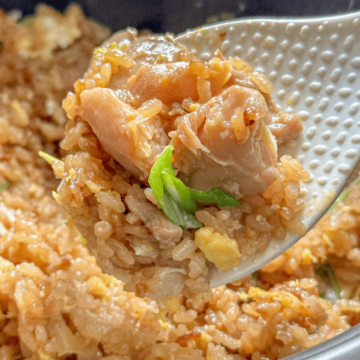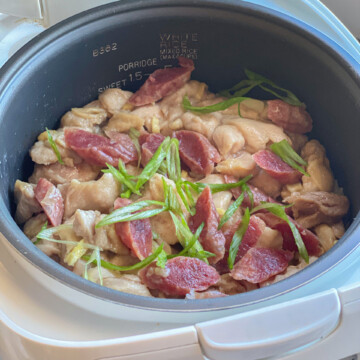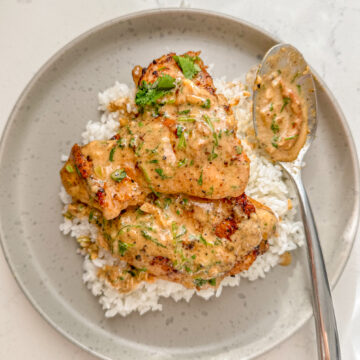You need to try this super easy One Pot Bibimbap (made in the rice cooker) when you have a busy night. This dish is made in the rice cooker and all you have to do is add all the ingredients (rice, beef, and veggies) in the rice cooker (or stovetop pot) and wait for the magic to happen! The result is a savory and spicy rice filled with lots of delicious vegetables and beef!

My recipe is a popular spin on the famous Korean dish called bibimbap, which translates to mixing rice in Korean. Traditionally, the bibimbap is served in a hot stone bowl known as a dolsot (the one I use is linked from Amazon). You let the rice crisp up on the dolsot and then mix everything together.
Why This Recipe Works
For our easy one pot bibimbap, we are skipping the steps of frying the seasoned vegetables and meat on the side. Instead, we will adding all our ingredients: bean sprouts, spinach, carrots, and bulgogi in the rice cooker. Then, we press the button and cook everything at the same time. This one pot recipe is perfect for those that are busy on weeknights or want something delicious that takes little effort. For a full Korean meal, serve with a kimchi bibim guksu, spicy soft tofu soup and Korean BBQ pork belly.
Jump to:
Ingredients:

You can substitute ingredients and customize the bibimbap (Korean rice bowl) to your liking! See below on what ingredients work well with this easy one pot meal! Check out another one pot beef and rice that uses similar ingredients to this recipe.
See recipe card below for a full list of ingredients and measurements.
- sliced beef – the thinly sliced beef is easy to cook and marinate. When cooked, the beef is soft and melts in your mouth.
- honey or sugar – this gives the bulgogi the sweet taste!
- marinated beef – add the beef and marinade directly in the rice so the rice can soak up it’s delicious flavor.
- shiitake mushrooms – you can use fresh or dry shiitake mushrooms add a nice texture and umami flavor to the rice.
- carrots – peeled and julienned for a nice texture when mixing the bibimbap.
- short grain white rice – this rice yields a chewy and sticky texture. If you want to use short grain brown rice, you can definitely used it! Just be mindful the water measurement may not be as accurate.
- bean sprouts – add at the end in the rice cooker to steam
- spinach – get the spinach without the stem. It cooks faster when you add at the end in the rice cooker to steam.
- fried egg (optional) – usually all bibimbap is served with a fried egg! The creaminess of the egg goes great with the rice.
- sesame oil – gives the rice a nice fragrant and nutty taste
- gochujang paste – this is all you need to add as a bibimbap sauce
- 1 teaspoon soybean paste (optional) – not traditional but I like the ssamjang taste!
- 1 tablespoon water (optional) – to make the sauce thinner
Additional Bibimbap Toppings and Variations:
- Change up the meats! You can use ground beef instead of sliced beef!
- To make vegetarian friendly, omit the beef and add tofu or more mushrooms. Ensure that the plant-based protein is ½ pound (the same proportion as the beef) and you squeezed out any additional moisture (you can use a paper towel to soak up the water) so the rice doesn’t get too soggy.
- More vegetable ideas: zucchini, broccoli, cauliflower, different types of mushrooms (oyster). Please keep in mind that if you add vegetables, you will need to add the same proportion as the ingredient you substituted. This ensures that everything in the pot can cook evenly. For example, if you’re swapping out zucchini for the beef, ensure that the zucchini is ½ pound proportion.
Equipment
Zojirushi rice cooker – this is the rice cooker I use and it works great! I bought it at Costco 8 years ago and it’s still reliable to this day. The rice always comes out delicious! I recommend checking Costco if they have this brand or you can buy it on Amazon. Use the ‘white rice’ setting!
How to Make One Pot Bibimbap:
In the next steps, I will show you how to prepare your beef marinade and slice your vegetables for your one pot meal!
Prepare the vegetables:
If you’re using dried shiitake mushrooms, soak them in water 1 hour prior to cooking. Thinly slice carrots and mushrooms. Set aside.

Step 1 & 2: Soak short grain rice in water. This helps ensure that the center of the rice is soft when cooked. Soak as long as it takes for you to prepare the beef chop the vegetables (roughly 15 minutes).
Marinate the beef:

Step 3: In a bowl, add soy sauce, honey, and oyster sauce. Mix sauce well and add the thinly sliced beef.
Step 4: Marinate the beef as long as it takes for you to prepare the other ingredients (roughly 10 minutes)
Wash rice and add all ingredients in the rice cooker:

Step 5: After washing rice, add ¾ cup water, sliced carrots and mushrooms in the rice.
Step 6: Mix together and add your marinated beef and black pepper on top. Place pot in rice cooker and press the cook button. If you don’t have a rice cooker, use the alternative cooking instructions below.
Add spinach and bean sprouts:

Step 7 & 8: When the rice is done cooking, add spinach and bean sprouts and close the lid. This helps steam them for 1-2 minutes. Serve with a sunny side egg, sesame oil and gochujang paste. Mix together and enjoy!!

StoveTop Cooking Instructions (if you don’t have a rice cooker)
Follow cooking instructions up until using a rice cooker. Use a pot and follow directions below.
- Heat pot to medium and cook for 5-7 minutes covered with a lid. The water will start boiling. Make sure to watch over the fire because the water might boil over ◡̈
- After 5-7 minutes, turn heat to low and cook for 10 more minutes covered. Do not open the lid during the entire cooking process.
- Then turn off the heat and do not open the covered pot. Leave for 15-20 minutes covered. After the 15-20 minutes is up, mix the rice well. Garnish with sunny side egg, toasted sesame oil, sesame seeds, and gochujang paste. Hope you enjoy with some roasted seaweed!
Recipe FAQs
I’ve tried a few different rice cookers for this recipe: Cuckoo, Zojirushi, and Instant Pot. When I used these rice cookers, these were the cooking settings I used for delicious results:
Cuckoo: The settings are ‘pressure cook, high heat, gluten rice.’ I’ve found that this rice is stickier and more wet. I recommend to add ¼ cup less water (total water: ¾ cup water).
Zojirushi (the best result!): The settings are ‘white rice.’ Follow the recipe and the rice will turn out great!
Instant Pot: The settings are ‘rice setting, more, 15 minutes, high pressure.’ Then let the rice sit for 10 more minutes without opening. I’ve found the rice to be more soft and saucy. The flavor is still great and this recipe works well in the Instant Pot.
You can place them in a bowl with a tight lid. Store in the refrigerator for up to 3 days. When you want to reheat the rice, place an ice cube or a damp paper towel on the rice and microwave for 1 minute.
I buy my thinly sliced beef at H-mart (Korean grocery store). Thinly sliced beef can also be purchased at other asian groceries like 99 ranch and Nijiya. If you can’t find it, you can also substitute with ground beef.
When serving bibimbap, the dish is accompanied with Korean side dish dishes such as kimchi or kimchi radish. You can also serve the bibimbap with a tasty soup such as this kimchi tuna jjigae. I love eating the rice with roasted seaweed for a nice crunch as well!
Expert Tips:
- Use short grain rice for this dish. Don’t forget to wash the rice in a strainer a few times until the water runs clear. If you don’t wash off the excess starch in the rice, the rice clumps together and tastes a little grainy when cooked. After washing the short grain rice, the grains will separate and make the rice smooth and soft!
- Use high quality (I prefer USDA prime chuck cuts) thinly sliced beef so the beef is tender and melts in your mouth. If you use thicker slices of beef, the beef will get overcooked and may have a tough texture.
- Soak the short grain rice in water while you prep the vegetables and beef. This helps soften the rice and give you great texture. Don’t worry, the rice is still chewy and tender, it will not be mushy after doing this.
- Gochujang can vary on spice and saltiness. When adding gochujang to your bibimbap, add a little bit at a time so you can taste if it’s good for you.
If you love one pot recipes, check out these easy meals!
- One pot Hainan chicken rice – steamed chicken with scallion ginger oil
- One pot curry chicken rice – delicious red curry sauce with chicken and rice
- Mushroom one pot rice – a flavorful rice dish filled with mushrooms and bamboo
Did you try this recipe? Leave a ⭐️ rating below and share it on Instagram, Facebook, and Pinterest!
Easy One Pot Bibimbap
Equipment
Ingredients
beef marinade
- ½ pound sliced beef
- 2 garlic cloves minced
- 4 teaspoon soy sauce
- 1 teaspoon honey
- 1 teaspoon oyster sauce
one pot rice
- 1 cup short grain white rice soaked in water
- ¾ cup water
- 3 shiitake mushrooms sliced
- ½ carrot (50 grams) julienne cut
- ¼ teaspoon black pepper
add in hot cooked rice
- handful bean sprouts
- handful spinach
garnish
- 1-2 tablespoon sesame oil
- 1 tablespoon gochujang paste
- 1 tablespoon toasted sesame seeds
- 1 teaspoon soybean paste optional
- 1 tablespoon water (optional) to make the gochujang sauce thinner
- 1 fried egg
Instructions
soak shiitake mushrooms if using dry (optional)
- If using dried shiitake mushrooms, soak them in water an hour prior to cooking and then gently squeeze out the water when slicing.
soak rice
- Soak short grain rice in water. Soak as long as it takes for you to prepare the beef and chop the vegetables (roughly 15 minutes).
- Mince garlic cloves. Add them in a bowl along with soy sauce, honey, and oyster sauce. Mix sauce well and add the thinly sliced beef. Marinate the beef as long as it takes for you to prepare the other ingredients (roughly 10 minutes)
- Peel and slice carrots. Slice in julienne cut (thin & long slices). Slice mushrooms.
- Wash the soaked rice in a strainer (or in the same bowl you used before) until water runs clear. Make sure your strain all the water to ensure that you add the right amount of water in the next step.
- In the pot with rice, add ¾ cup water, sliced carrots and mushrooms. Mix together and add your marinated beef and black pepper on top. Place pot in rice cooker and press the cook button. If you don’t have a rice cooker, use the alternative cooking instructions below.
- (Optional) To make the bibimbap sauce, you can use gochujang paste only. However, I like to add some water to make the sauce thinner and add soybean paste for some depth of flavor. Set sauce aside.
- When the rice is done cooking, open the lid quickly and be careful of the steam. Add the spinach and bean sprouts quickly and close. Steam for 2 minutes and open the lid. Mix everything together.
- This is optional, fry sunny side eggs on a pan and place on top of the rice. Garnish with a teaspoon of sesame oil, bibimbap sauce, and sesame seeds. Mix your sauce with your rice and hope you enjoy!
Notes
- Heat pot to medium and cook for 5-7 minutes covered with a lid. The water will start boiling. Make sure to watch over the fire because the water might boil over ◡̈
- After 5-7 minutes, turn heat to low and cook for 10 more minutes covered. Do not open the lid during the entire cooking process.
- Then turn off the heat and do not open the covered pot. Leave for 15-20 minutes covered. After the 15-20 minutes is up, mix the rice well. Garnish with gochujang paste, sesame seeds, sesame oil and a fried egg (optional). Hope you enjoy with some roasted seaweed.
-
- Use short grain rice for this dish. Don’t forget to wash the rice in a strainer a few times until the water runs clear. If you don’t wash off the excess starch in the rice, the rice clumps together and tastes a little grainy when cooked. After washing the short grain rice, the grains will separate and make the rice smooth and soft!
-
- Use high quality (I prefer USDA prime chuck cuts) thinly sliced beef so the beef is tender and melts in your mouth.
-
- Soak the short grain rice in water while you prep the vegetables and beef. This helps soften the rice and give you great texture. Don’t worry, the rice is still chewy and tender, it will not be mushy after doing this.
-
- When adding gochujang to your bibimbap, add a little bit at a time so you can taste if it’s good for you.
- Can substitute ingredients if you ensure that the proportion is the same. For example, sub ½ pound thinly sliced beef with ½ pound ground beef.










Anne says
Hi, for your rice cooker rice recipes, are you using the cup that comes with the rice cooker or the standard measuring cups?
Dana says
Hello, I use standard measuring cups!
Dylan Mopia says
I love this recipe so much! I’m a college student in a dorm so it’s perfect for me.
Sandy Roycraft says
We often go out to our local Korean Bibimbap restaurant but I wanted to try making it at home. Thanks to this recipe, I was able to do so with resounding success! My husband agrees that I have mastered the art of Bibimbap, thanks to Dana!
Erin ODonnell says
usually rice cooker meals end up half cooked with mushy rice but this recipe was so yummy! it exceeded my expectations. will make again.
Michelle K says
This is one of my fav dishes! Cooking it in the rice cooker makes it so easy.
Jenny C says
I love bibimbap and how easy this recipe was!! Definitely hits the spot
Tony says
Love this recipe! It was quite simple and straightforward. Can’t wait to try out other recipes 🙂
Eryca says
This recipe has become a weeknight staple! So yummy and so easy! Thank you for sharing!
Inez says
Going to make this!
Rachael Bouwer says
Very filling and nutritious- I’ve been adding enoki mushrooms and other veggies/fungus to mix it up.
Really easy to make and it works with my university student lifestyle.
Gabby says
Looks delicious and simple!